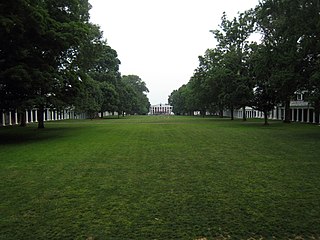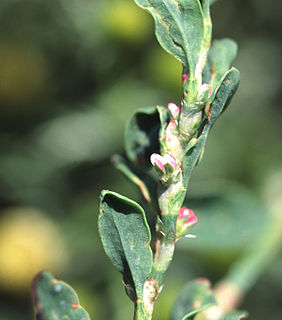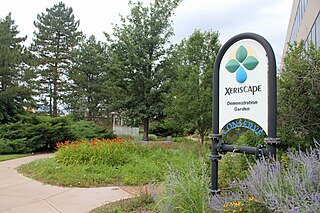
A road verge is a strip of grass or plants, and sometimes also trees, located between a roadway (carriageway) and a sidewalk (pavement). Verges are known by dozens of other names, often quite regional; see Terminology, below.

Weed control is the botanical component of pest control, which attempts to stop weeds, especially noxious weeds, from competing with desired flora and fauna including domesticated plants and livestock, and in natural settings preventing non native species competing with native species.

A lawn is an area of soil-covered land planted with grasses and other durable plants such as clover which are maintained at a short height with a lawnmower and used for aesthetic and recreational purposes. Lawns are usually composed only of grass species, subject to weed and pest control, maintained in a green color, and are regularly mowed to ensure an acceptable length. Lawns are used around houses, apartments, commercial buildings and offices. Many city parks also have large lawn areas. In recreational contexts, the specialised names turf, pitch, field or green may be used, depending on the sport and the continent.
A mulch is a layer of material applied to the surface of soil. Reasons for applying mulch include conservation of soil moisture, improving fertility and health of the soil, reducing weed growth and enhancing the visual appeal of the area.

See pervious concrete for pervious slab pavement surfaces.
Pavement, in construction, is an outdoor floor or superficial surface covering. Paving materials include asphalt, concrete, stones such as flagstone, cobblestone, and setts, artificial stone, bricks, tiles, and sometimes wood. In landscape architecture, pavements are part of the hardscape and are used on sidewalks, road surfaces, patios, courtyards, etc.

A driveway is a type of private road for local access to one or a small group of structures, and is owned and maintained by an individual or group.

Groundskeeping is the activity of tending an area of land for aesthetic or functional purposes; typically in an institutional setting. It includes mowing grass, trimming hedges, pulling weeds, planting flowers, etc. The U.S. Department of Labor estimated that more than 900,000 workers are employed in the landscape maintenance and groundskeeping services industry in the United States in 2006. Of these over 300,000 workers were greenskeepers for golf courses, schools, resorts, and public parks. Compare gardener.

Polygonum arenastrum, commonly known as equal-leaved knotgrass, is a summer annual flowering plant in the knotweed family Polygonaceae. Other common names include common knotweed, prostrate knotweed, mat grass, oval-leaf knotweed, stone grass, wiregrass, and door weed, as well as many others. It is native to Europe and can be found on other continents as an introduced species and a common noxious weed. Knotweed was first seen in North America in 1809 and is now seen across much of the United States and Canada.

Bioswales are channels designed to concentrate and convey stormwater runoff while removing debris and pollution. Bioswales can also be beneficial in recharging groundwater.

A curb, or kerb, is the edge where a raised sidewalk or road median/central reservation meets a street or other roadway.
This is an alphabetical index of articles related to gardening.
In permaculture, sheet mulching is an agricultural no-dig gardening technique that attempts to mimic the natural soil-building process in forests. When deployed properly and in combination with other permaculture principles, it can generate healthy, productive, and low maintenance ecosystems.

A snowmelt system prevents the build-up of snow and ice on cycleways, walkways, patios and roadways, or more economically, only a portion of the area such as a pair of 2-foot (0.61 m)-wide tire tracks on a driveway or a 3-foot (0.91 m) center portion of a sidewalk, etc. It is also used to keep entire driveways and patios snow free in snow prone climates. The "snow melt" system is designed to function during a storm thus improve safety and eliminate winter maintenance labor including shoveling or plowing snow and spreading de-icing salt or traction grit (sand). A snowmelt system may extend the life of the concrete, asphalt or under pavers by eliminating the use of salts or other de-icing chemicals, and physical damage from winter service vehicles. Many systems are fully automatic and require no human input to maintain a snow/ice fee horizontal surface.

Xeriscaping is the process of landscaping, or gardening, that reduces or eliminates the need for irrigation. It is promoted in regions that do not have accessible, plentiful, or reliable supplies of fresh water and is gaining acceptance in other regions as access to irrigation water is becoming limited; though it is not limited to such climates. Xeriscaping may be an alternative to various types of traditional gardening.

A weed is a plant considered undesirable in a particular situation, "a plant in the wrong place". Examples commonly are plants unwanted in human-controlled settings, such as farm fields, gardens, lawns, and parks. Taxonomically, the term "weed" has no botanical significance, because a plant that is a weed in one context is not a weed when growing in a situation where it is in fact wanted, and where one species of plant is a valuable crop plant, another species in the same genus might be a serious weed, such as a wild bramble growing among cultivated loganberries. In the same way, volunteer crops (plants) are regarded as weeds in a subsequent crop. Many plants that people widely regard as weeds also are intentionally grown in gardens and other cultivated settings, in which case they are sometimes called beneficial weeds. The term weed also is applied to any plant that grows or reproduces aggressively, or is invasive outside its native habitat. More broadly "weed" occasionally is applied pejoratively to species outside the plant kingdom, species that can survive in diverse environments and reproduce quickly; in this sense it has even been applied to humans.
Sustainable landscaping is a modern type of gardening or landscaping that takes the environmental issue of sustainability into account. According to Loehrlein in 2009 this includes design, construction and management of residential and commercial gardens.

Block paving also known as brick paving is a commonly used decorative method of creating a pavement or hardstanding. The main benefit of bricks over other materials is that individual bricks can later be lifted up and replaced. This allows for remedial work to be carried out under the surface of the paving without leaving a lasting mark once the paving bricks have been replaced. Typical areas of use would be for driveways, pavement, patios, town centres, pedestrian precincts and more commonly in road surfacing. Bricks are typically made of concrete or clay, though other composite materials are also used. Each has its own means of construction. The biggest difference is the way they set hard ready for use. A clay brick has to be fired in a kiln to bake the brick hard. A concrete brick has to be allowed to set. The concrete paving bricks are a porous form of brick formed by mixing small stone hardcore, dyes, cement and sand and other materials in various amounts. Many block paving manufacturing methods are now allowing the use of recycled materials in the construction of the paving bricks such as crushed glass and crushed old building rubble.

Rent A Goat is a company founded in 2010 by 22-year-old entrepreneur Matthew Richmond, from Chapel Hill, North Carolina, which rents out goat herds for land-clearing purposes. Rent A Goat is part of a larger phenomenon called conservation grazing or targeted grazing whereby goats are used instead of traditional machinery or pesticides in order to curb unwanted invasive plant growth. Goat rental has since become a more publicly acceptable form of weed abatement according to The Street: "Whether you have just enough front or back yard to get overgrown and unwieldy or find yourself overrun with nasty, prickly, invasive plants that just won't go away, nature has already devised the ultimate solution to your problem."

Moss lawns are lawns composed of moss, which are grown as an alternative to grass lawns. They are a defining element in moss gardens.















